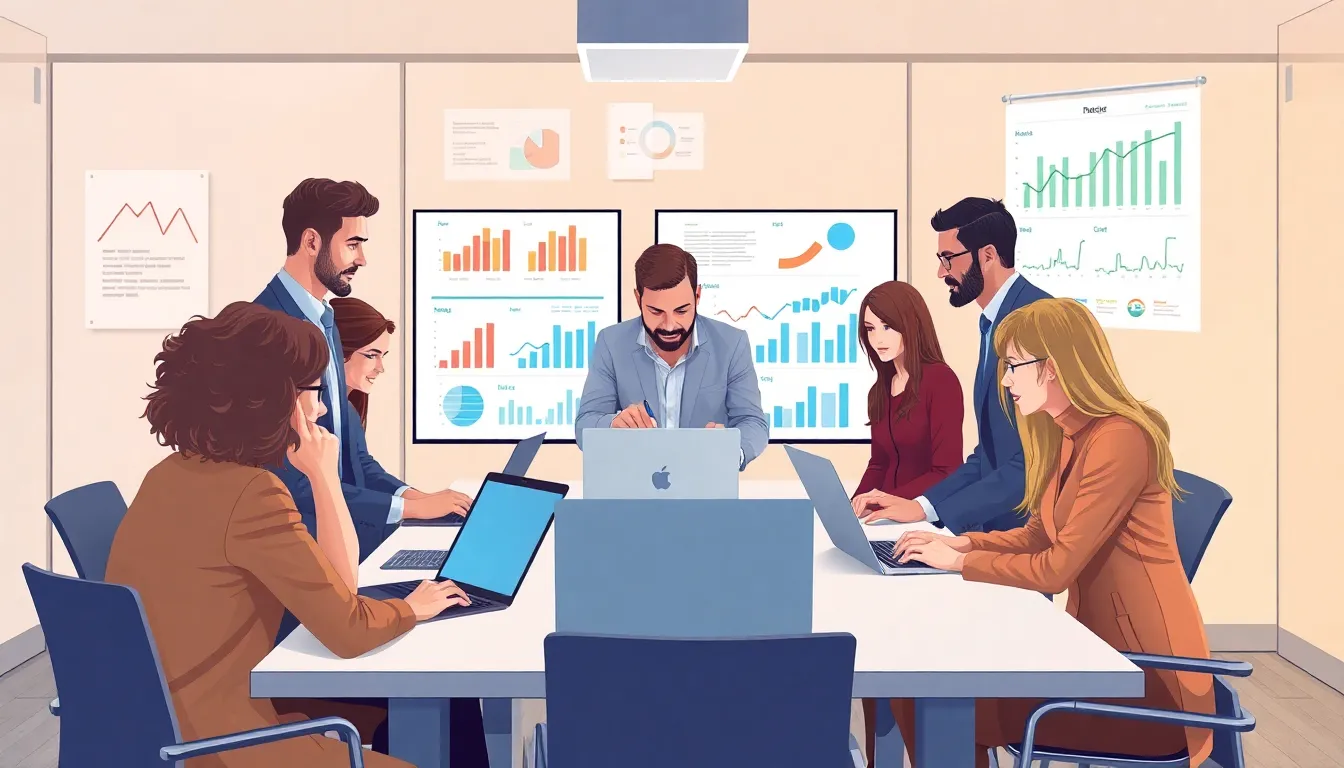Table of Contents
ToggleIn the fast-paced world of procurement, staying ahead of the curve is no longer just a smart move; it’s a necessity. With emerging technologies popping up like popcorn in a hot pan, organizations must adapt or risk being left in the dust. From artificial intelligence to blockchain, these innovations are revolutionizing how businesses source and manage their suppliers.
Imagine a procurement process where manual tasks are automated, data is analyzed in real-time, and decisions are made with laser-like precision. Sounds like something out of a sci-fi movie, right? But it’s happening now, and savvy companies are reaping the rewards. Embracing these technologies not only streamlines operations but also positions organizations as leaders in a competitive market. So, buckle up as we explore the exciting landscape of emerging technologies in procurement and how they can transform the way businesses operate.
Overview Of Emerging Technologies In Procurement
Emerging technologies significantly impact procurement operations. Artificial intelligence automates repetitive tasks, allowing procurement teams to focus on strategic decisions. Additionally, machine learning analyzes vast amounts of data to improve supplier selection and risk assessment.
Blockchain enhances transparency and traceability in supply chains. The decentralized nature of blockchain prevents fraud and ensures data integrity, increasing trust among stakeholders. Furthermore, smart contracts automate agreements, reducing the time and resources spent on transaction management.
Cloud computing revolutionizes how procurement teams collaborate. Centralized access to data supports real-time communication and document sharing among employees and suppliers. This instant accessibility fosters better relationships and quicker decision-making.
Robotic process automation streamlines repetitive processes. This technology increases efficiency by handling tasks such as invoice processing and order management without human intervention. As a result, teams can allocate their resources towards higher-value activities.
Internet of Things devices contribute to smarter supply chains. Sensors in production facilities monitor equipment health and environment conditions, ensuring optimal performance and minimizing downtime. Data collected from IoT devices enables companies to make informed decisions regarding inventory and logistics.
Moreover, advanced analytics tools empower procurement professionals to identify trends and forecast future supply chain disruptions. Predictive analytics uses historical data to anticipate challenges, enabling proactive measures. This capability allows businesses to remain agile amidst changing market conditions.
These technologies reshape the procurement landscape by enhancing efficiency, transparency, and collaboration. Integrating them into existing processes not only prepares organizations for future challenges but also positions them for sustainable growth in a competitive marketplace.
Impact On Procurement Processes


Emerging technologies significantly influence procurement processes. Adapting to these innovations allows organizations to enhance efficiency and decision-making.
Automation And Efficiency
Automation streamlines repetitive tasks, enabling teams to focus on strategic goals. Robotic process automation handles activities like invoice processing, which reduces manual workload. Companies save time and resources through smarter contract management, too. Artificial intelligence improves supplier interactions, allowing for quicker problem resolution. This shift promotes a more agile procurement process overall. Efficiency rises as teams embrace automation, freeing them to concentrate on high-value initiatives.
Data-Driven Decision Making
Data-driven decision-making transforms procurement strategies. Advanced analytics tools empower professionals to identify trends and anticipate disruptions. Machine learning analyzes supplier performance, enhancing selection criteria. Real-time data access allows procurement teams to adapt quickly to market changes. Improved insights lead to better supplier relationships and negotiation outcomes. Organizations leverage analytics to forecast demands accurately, which optimizes inventory management. Ultimately, data-driven decisions elevate sustainability and competitiveness in the procurement landscape.
Key Technologies Transforming Procurement
Emerging technologies are reshaping the procurement landscape, driving efficiency and enhancing decision-making. Innovations like artificial intelligence, blockchain, and the Internet of Things play pivotal roles in this transformation.
Artificial Intelligence And Machine Learning
Artificial intelligence automates numerous repetitive tasks, shifting focus to strategic decision-making. Machine learning enhances supplier selection by analyzing large datasets to identify reliable partners. Data-driven insights improve risk assessment, allowing procurement teams to respond to potential issues proactively. These technologies streamline operations and facilitate quicker interactions, resulting in more effective supplier relationships.
Blockchain Technology
Blockchain technology introduces unprecedented transparency and traceability within supply chains. It ensures data integrity by preventing fraud through immutable records. Smart contracts automate agreements, reducing the time needed for manual processing. Moreover, blockchain fosters trust among stakeholders by providing a clear history of transactions, which is essential for compliance and auditing purposes.
Internet Of Things (IoT)
Internet of Things devices play a crucial role in creating smarter supply chains by enabling real-time monitoring of equipment. Sensors track conditions and performance, providing data that facilitate maintenance and risk management. These insights enhance operational efficiency and minimize disruptions. By connecting devices, organizations gain a competitive edge through improved decision-making based on actual conditions in supply chains.
Challenges And Considerations
Emerging technologies in procurement present several challenges that organizations must navigate. Adapting to new advancements often requires significant adjustments in processes and culture.
Implementation Barriers
Implementation barriers frequently hinder the adoption of new technologies. Resistance to change often arises among employees, leading to slow integration. Budget constraints present another challenge, as costs for new technologies can be substantial. Infrastructure limitations may also affect seamless technology adoption. Stakeholders must address these issues collectively to ensure successful integration that fosters operational efficiency.
Skill Gaps In The Workforce
Skill gaps in the workforce impact effective utilization of emerging technologies. Many employees may lack expertise in data analysis or AI, reducing the technologies’ effectiveness. Training programs can help bridge these gaps, but organizations often face obstacles in resource allocation and employee engagement. Investing in continuous learning initiatives promotes technological adoption. Stronger skill sets among team members lead to improved procurement processes that leverage the full potential of innovative tools.
Future Trends In Procurement Technology
Artificial intelligence continues to be a driving force in procurement technology, improving supplier selection and assessment. Machine learning enhances data analysis capabilities, enabling teams to make informed decisions faster. Organizations leverage real-time insights to respond swiftly to market changes and boost supplier relationships.
Blockchain technology offers enhanced transparency in supply chains. By ensuring traceability, it helps organizations prevent fraud and secure data integrity. Smart contracts automate procurement agreements, saving both time and resources. Such advancements foster trust and compliance among stakeholders.
Cloud computing transforms collaboration within procurement teams. Centralized data access promotes efficient communication between employees and suppliers. Organizations thrive when they can make swift decisions based on readily available information.
Robotic process automation increases operational efficiency by managing tasks like invoice processing. The reduction of manual workloads allows teams to focus on strategic activities that add greater value. Organizations benefit from engaging in higher-level strategies rather than routine chores.
The Internet of Things enables smarter supply chains through real-time monitoring of equipment and conditions. Data collection from IoT devices helps organizations anticipate maintenance needs and manage risks effectively. Such insights lead to minimized disruptions and improved decision-making.
Emerging technologies reshape procurement landscapes by enhancing efficiency and transparency. Organizations see improved collaboration as technology facilitates quicker interactions between stakeholders. Investment in training programs becomes crucial to address skill gaps. When employees embrace technological innovations, procurement processes become more effective, positioning organizations for future growth.



